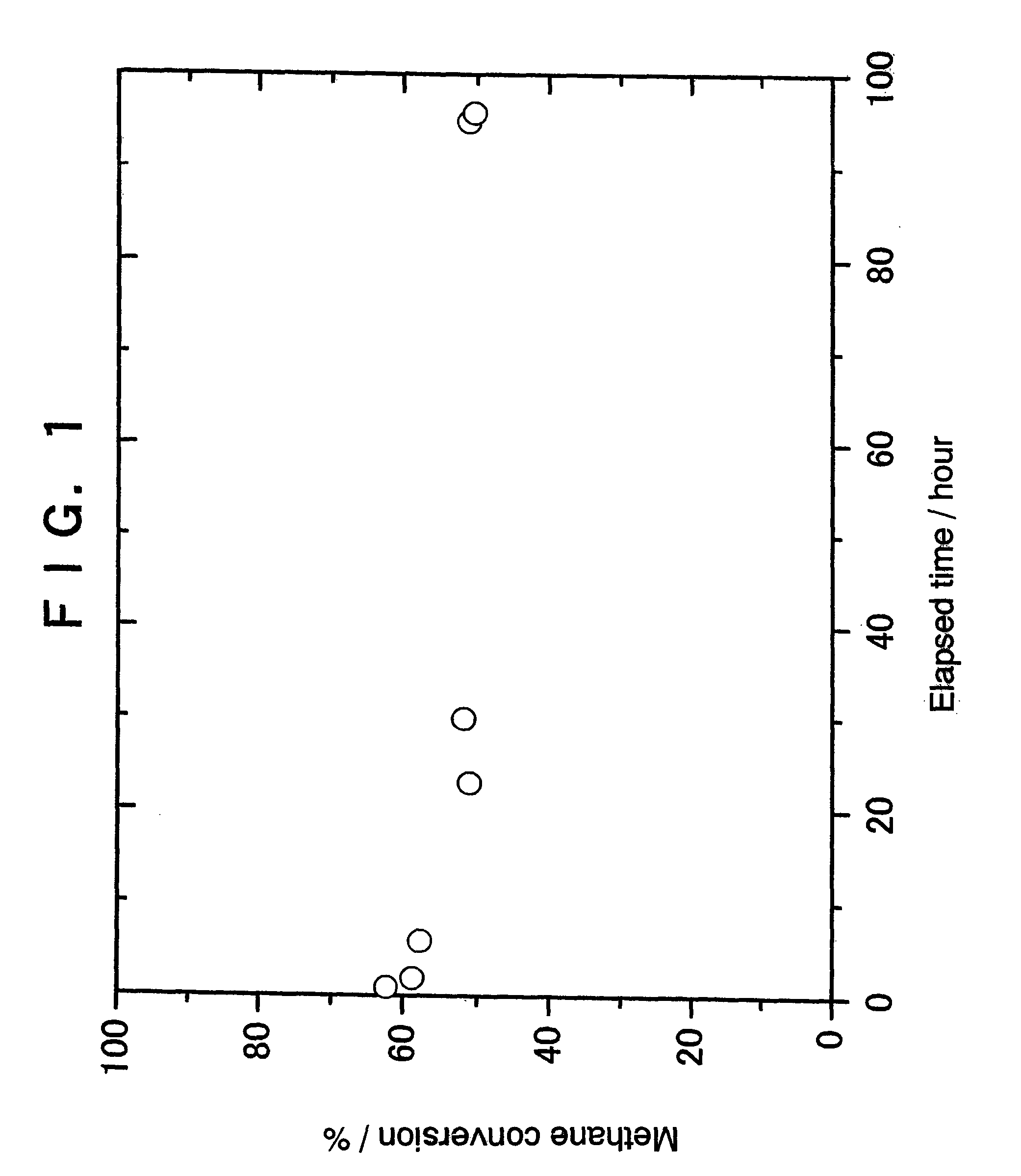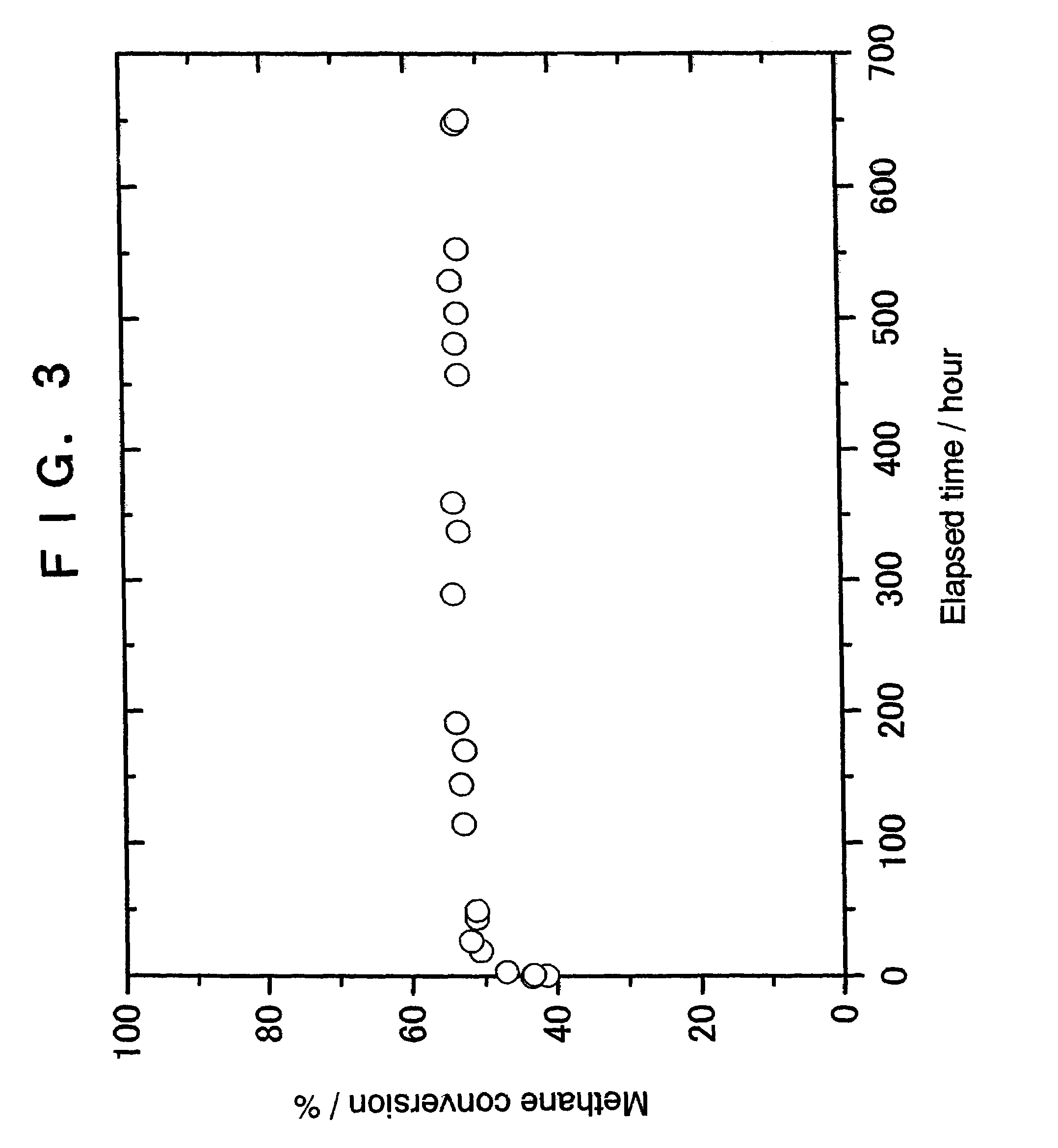Catalyst for purifying methane-containing waste gas and method of purifying methane-containing waste gas
a technology of methane and waste gas, which is applied in the direction of physical/chemical process catalysts, metal/metal-oxide/metal-hydroxide catalysts, and separation processes, etc. it can solve the problems of catalyst significantly reducing the activity of catalyst, catalyst to substantially lose its activity, and catalyst to achieve sufficient oxidative decomposition. , to achieve the effect of high methane conversion, high methane oxidation activity, and excellent resistance to activity inhibition
- Summary
- Abstract
- Description
- Claims
- Application Information
AI Technical Summary
Benefits of technology
Problems solved by technology
Method used
Image
Examples
example 1
Preparation of 2% Ir / zirconia Catalyst
[0056]A 0.305 g quantity of tris(acetylacetonato)iridium [Ir(acac)3:acac═CH3COCHCOCH3−] was dissolved in 8 ml of 69% nitric acid with heating. The resultant solution was diluted by adding 5 ml of pure water, thereby preparing an impregnation solution.
[0057]Then, 6 g of zirconia (manufactured by Tosoh Corporation, TZ-O; specific surface area=14 m2 / g) was immersed in the above impregnation solution for 15 hours. The mixture was then evaporated to dryness, and the solid was calcined in air at 500° C. for 4 hours, giving a 2% Ir / zirconia catalyst.
example 2
Preparation of 5% Ir-1% Pt / zirconia Catalyst
[0058]A 0.763 g quantity of tris(acetylacetonato)iridium and 0.099 g of cis-diamminedinitroplatinum [Pt(NO2)2(NH3)2] were dissolved in 16 ml of 69% nitric acid with heating. To the resultant solution was added a solution obtained by diluting 0.5 ml of 69% nitric acid with 5 ml of pure water, thus preparing a diluted impregnation solution.
[0059]Then, 6 g of zirconia (manufactured by Tosoh Corporation, TZ-O; specific surface area=14 m2 / g) was immersed in the above impregnation solution for 15 hours. The mixture was then evaporated to dryness, and the solid was calcined in air at 500° C. for 4 hours, giving a 5% Ir-1% Pt / zirconia catalyst.
example 3
Preparation of 2% Ir-1% Pt / zirconia Catalyst
[0060]A 0.178 g quantity of tris(acetylacetonato)-iridium and 0.058 g of cis-diamminedinitroplatinum were dissolved in 4 ml of 69% nitric acid with heating. To the resultant solution was added a solution obtained by diluting 0.5 ml of 69% nitric acid with 5 ml of pure water, thus preparing a diluted impregnation solution.
[0061]Then, 3.5 g of zirconia (manufactured by Tosoh Corporation, TZ-O; specific surface area=14 m2 / g) was immersed in the above impregnation solution for 15 hours. The mixture was then evaporated to dryness, and the solid was calcined in air at 500° C. for 4 hours, giving a 2% Ir-1% Pt / zirconia catalyst.
PUM
| Property | Measurement | Unit |
|---|---|---|
| temperature | aaaaa | aaaaa |
| specific surface area | aaaaa | aaaaa |
| concentration | aaaaa | aaaaa |
Abstract
Description
Claims
Application Information
 Login to View More
Login to View More - R&D
- Intellectual Property
- Life Sciences
- Materials
- Tech Scout
- Unparalleled Data Quality
- Higher Quality Content
- 60% Fewer Hallucinations
Browse by: Latest US Patents, China's latest patents, Technical Efficacy Thesaurus, Application Domain, Technology Topic, Popular Technical Reports.
© 2025 PatSnap. All rights reserved.Legal|Privacy policy|Modern Slavery Act Transparency Statement|Sitemap|About US| Contact US: help@patsnap.com



